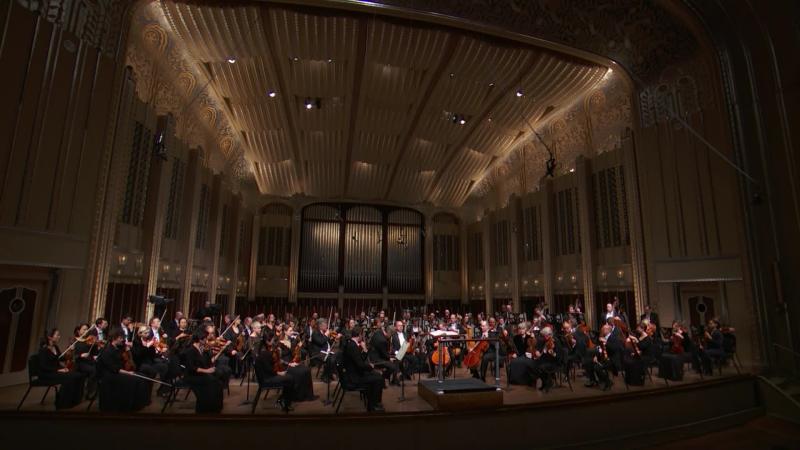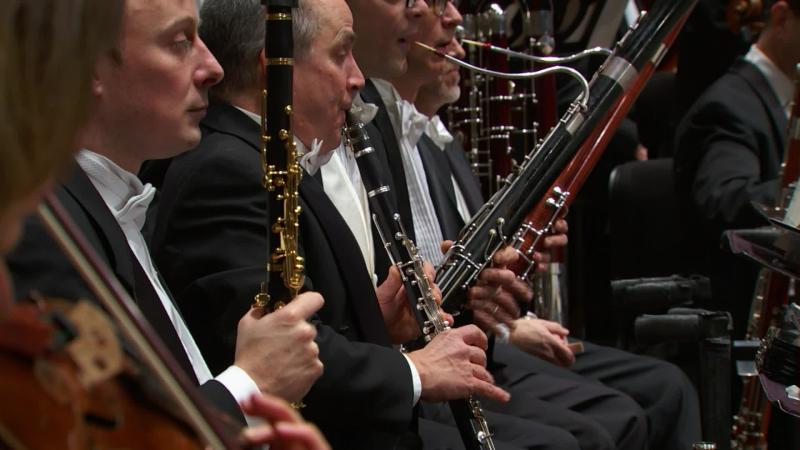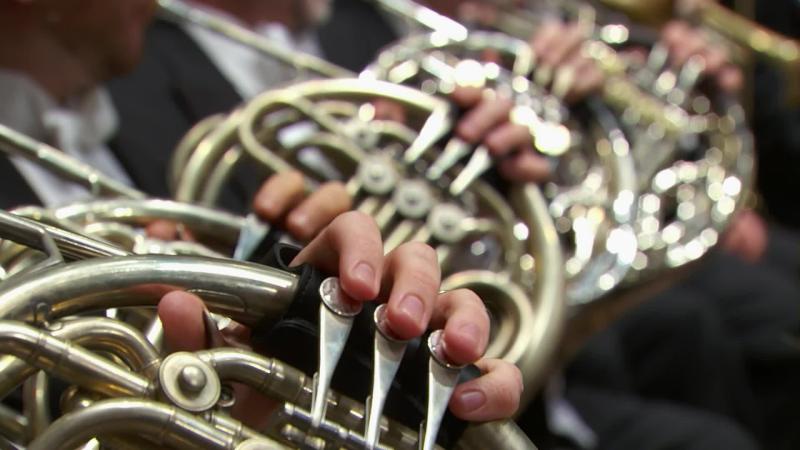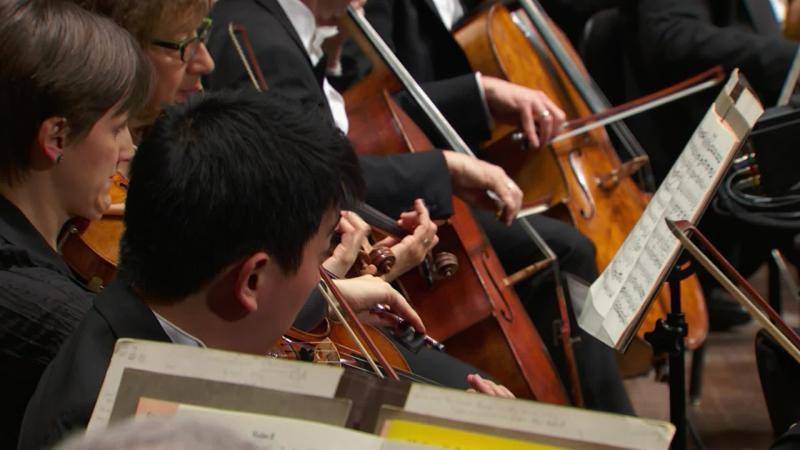
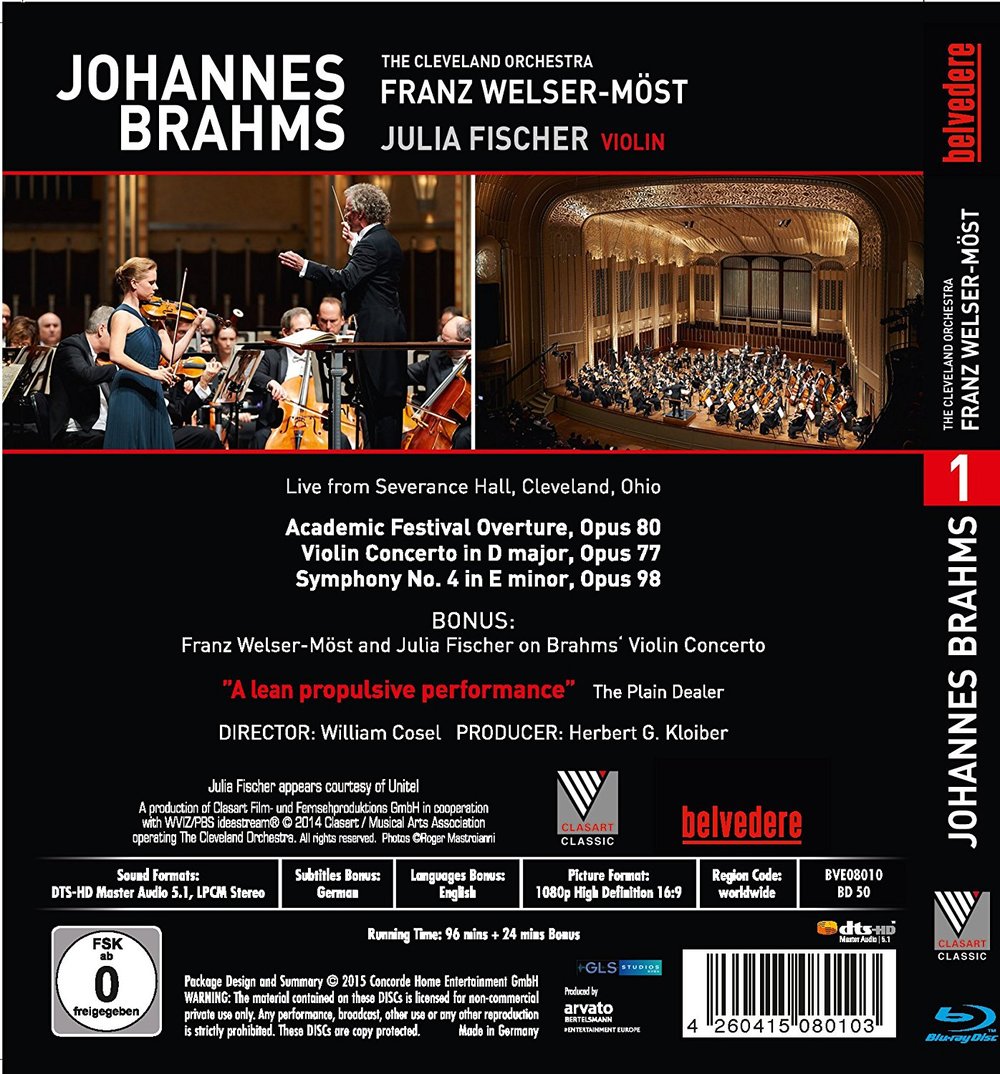
Brahms Violin Concerto and Symphony No. 4 concert. Franz Welser-Möst conducts the Cleveland Orchestra in 2014 at Severance Hall, Cleveland. The disc also includes Brahms Academic Festival Overture. Julia Fischer is the violin soloist. This disc also is available as part of a box set with Brahms' most famous symphonic works. Audio produced by Elaine Mortone; Directed for TV by William Cosel; Produced by Herbert G. Kloiber. Released 2017, disc has 5.1 dts-HD Master Audio sound. Grade: For the Violin Concerto: A For Symphony No. 4: D- (The Academic Festival Overture is not reviewed.)
Brahms Violin Concerto
Here's a shot of the whole orchestra (WO) in warm-up before Julia Fischer comes out. It's great to have a chance early to see where all the musicians are sitting. The resolution, however, is only good --- not the best:
The concerto is beginning and we get yet another WO view of the various sections - how nice!
And now a part orchestra (PO) shot with a closer view of the cellos and basses:
Julia Fischer had been an A level violin soloist for over a decade when she made this recording. She was also a concert pianist who could play most of the famous piano concertos (usually with top student orchestras or other special groups). Finally, she was a professor teaching at the university level in Munich. A busy lady, she still had the energy to find Brahms' passion lurking within his classical concerto form. Following are 2 "realistic" shots of Fischer as soloist:
Next below is a "non-realistic" shot. This is not a view a member of the audience could have, so we deem it to be of lower value than the realistic images:
Is this a conductor shot or a non-realistic view of Fischer? There's nothing inherently wrong with these kinds of views, but we like for the majority of the shots of the soloist to be realistic:
And here's a close-up of Welser-Möst watching Fischer in her credenza. I think he feels the same thing I do when watching this — i.e., awe:
Fischer gets far more clips in the video than the orchestra. But as explained in the bonus extra, Brahms wrote rich music for the orchestra also. When working on a concerto, I think the TV director and his crew get more time to focus on good shots of the orchestra than they do when filming a symphony. The next shot below of the horns and trumpets is impressive with beautiful framing and a nice focus over quite a distance:
And here's a decent shot of the basses:
And here is an example of what appears to be a William Cosel trade-mark: two related but divided images playing simultaneously. There are 8 shots like this in this record, and I called them "Other high value." The shot on the left shows Fischer bowing and fingering the violin. I consider these fingering shots to be high-value because it's interesting to see how she does this. So I count these views as realistic:
And there are only 5 conductor-over-backs views in this video (not 25+ like we often see). But why would you do even one shot like this when you have such a beautiful and talented soloist to watch from the front?
Alas, Cosel loves to pan and zoom. Too often the result is blur as you see below. Moving the camera should rarely be done in a symphony video, and then so slowly as to just be barely perceptible to the viewer:
And there are also some other errors in this film. In the shot next below you see pieces of 7 musicians. Which one is in focus? In anyone in focus?
And what is Cosel trying to do with the next shot below:
We get the image next below in the middle of the film. I counted this as a WO, but it's really not. If you show this before the concert starts, it can be a high-value architectural view. But if you show this while the music is playing, it's just a useless "anthill":
I did a Wonk Worksheet for this concerto.
There are 39 minutes, 10 seconds of music divided into 265 video clips. This yields the (too rapid) pace of 8.9 seconds per clip.
Here's the clip breakdown:
Conductor shots = 40
Conductor-over-backs shots = 5
Soloist not realistic =42
*Soloist realistic = 96
Solo and other small-scale clips = 47
*Large-scale clips = 5
*Part-orchestra clips = 4
*Whole-orchestra clips = 13
Instrument-only clips = 3
Other low-value shots = 1
*Other high value=9
There are 127 "supershots" (add up the * numbers above of 96+5+4+13+9). So the supershots are 47% of the total clips (127/265). Conductor shots total 45 (40+5), and conductor shots use up 17% of the clips (45/265).
HDVDarts.com has established the following rules-of-thumb to identify a Blu-ray with DVDitis:
“A good symphony HDVD should have a slow pace with more than 10 seconds per video clip on average. 20 to 40% of the clips should be large-scale "supershots." Conductor shots should be less (way less really) than 20% of the clips in the video.”
Subject title fails the pace test with the average clip running less than 10 seconds, but the pace of 8.9 seconds is close. All the other tests are passed handsomely. So I would say this concerto film is like my friend who needs to lose weight because the doctor called him "pre-diabetic." I'll not diagnose DVDitis in this case, and that's pretty rare these days with our symphony HDVDs!
Now for a grade. I start with A+ and reduce the grade to A for lack of 96kHz/24-bit sound sampling. SQ is good with all the sections and instruments well represented in the mix. PQ is acceptable even if resolution is not as sharp as I would like. I'll reduce the grade to A- for these weaknesses in PQ.
But there are other reasons to consider an upgrade. First, I think this is one of the very best solo violin performances I've seen. I also liked the sound recording because I can always clearly hear the violin. (Richard Osborne, writing in the January 2016 Gramophone at page 29, takes the other view and bemoans the "closeness! with which the violin is recorded.) Finally, I was really happy to have plenty of WO shots at the beginning of the record. So that gets me back to an A, which is a rare feat for any of our Western recording companies that tend to be so saturated with DVDitis and other video sloppiness. I will cheerfully show this concerto to friends and neighbors in my HT.
Symphony No. 4
The bliss I felt watching Julia Fischer reminded me of gliding on a gondola through fabled Venice. Alas, after watching the Cleveland Orchestra in this Brahms Symphony No. 4, I felt like I had been dumped into the smelly canal. This Brahms 4 suffers from both a flagrant case of DVDitis and a shocking case of VADHD (video attention-deficit hyperactivity disorder). But before we do our clinical analysis, let's see some screenshots. This first image below is supposed to be a WO shot giving the viewer a chance to see the organization of the band. But alas, the shot is to low to have much value, and the resolution seems to me closer to a DVD than a Blu-ray disc:
Dragged down by poor resolution, this image becomes an anthill to me:
And if you know anything about DVDitis, you know that the use of tons of close-ups is one of its symptoms. Well, subject video has lots of close-up images like the next four below . . . you might think you have gone the movies:
Not every image is so extreme. Here's a decent shot of the cellos:
And here's an admirable framing that gets at least something of all 9 basses into the act:
But oops! What's this? Earlier above I approved of Cosel's odd-ball double images. But here's a double play with two instrument-only shots, for which we have to give a double demerit:
And here next below is one of 11 dreaded conductor-over-backs shots in this film. Why would you insult both the conductor and the members of the orchestra with such an inane frame?
And here next below is a "back-of-the-conductor shot" --- is this a new low in videographic laziness?
And here's a shot with body parts of 7 musicians, but only one player is actually doing anything:
How did this mess of out-of-focus horns get past the editor?
Here next below are the faces of 6 of the 11 violas. They remind me of serfs pulling a barge down the Volga river:
What is this? A haircut shot?
And here's a dandy right-elbow shot:
We interrupt this concert to show you some excellent millwork at Severance Hall:
So do you think I'm rotten cherry-picking? Well I ran a Wonk Worksheet to defend myself. There are more problems in this video than jailbirds nesting in the swamp of Washington DC.
There are 37 minutes, 26 seconds of music divided into 349 video clips. This yields a rapid pace of 6.4 seconds per clip.
Here's the clip breakdown:
Conductor shots = 73
Conductor-over-backs shots = 11
Solo and other small-scale clips = 164
*Large-scale clips = 27
*Part-orchestra clips = 18
*Whole-orchestra clips = 13
Instrument-only clips = 18
Other low-value shots = 15 (mostly framing and focus errors)
*Other high-value shots = 10
There are only 68 "supershots" (add up the * numbers above of 27+18+13+10=68). So the supershots are only 19% of the total clips (68/349). Conductor shots total 84 (73+11), and conductor shots use up 24% of the clips (84/349).
HDVDarts.com has established the following rules-of-thumb to identify a Blu-ray with DVDitis:
“A good symphony HDVD should have a slow pace with more than 10 seconds per video clip on average. 20 to 40% of the clips should be large-scale "supershots." Conductor shots should be less (way less really) than 20% of the clips in the video.”
Subject title flunks all 3 tests and is infected with DVDitis. In addition, as mentioned at the outset, there is another serious illness afflicting this video: VADHD, which stands for video attention-deficit hyperactivity disorder. VADHD is diagnosed because the video director insists on panning or zooming — rapidly — in virtually every clip where it is possible to do so. Generally, there's no added motion to extreme close-ups of one or several players or shots of the conductor. But in larger-scale views, the TV director here is like a hyperactive child: there must be constant agitation! Obviously, the TV director believes this showing off of his abilities adds value. But most of the time, motion within a clip only interferes with the ability of the viewer to comprehend what is going on in the performance. To keep track of fast-moving images, the viewer's brain is distracted from hearing the music! I don't detect a serious VADHD problem in most symphony titles — but where it's present, it's as serious a defect as DVDitis.
Richard Osborne, writing in the January 2016 Gramophone at page 28, complains that this recording of Brahms Symphony No. 4 is "more a jaunt than a journey." He means by this that the interpretation is "underpowered." That's a really subjective call. Could it be that Osborne was in fact reacting to the DVDitis and VADHD issues I discuss in the previous paragraph?
Now for a grade. It's hard to believe this video was done by the same folks who did the Julia Fischer concerto. But this symphony video has nothing going for it. Its flunks the video content tests completely and is hyper-active. There are no good WO orientation shots. There are too many instrument-only and other low-value views. This could justify an F grade. But I listened to this Brahms S4 in audio-only mode, and the performance was reasonably enjoyable without the video. So out of respect for a great conductor and orchestra, I'll move the grade up to D-. After you watch the beautiful Julia Fischer video, just treat the rest of the Blu-ray as a CD.
OR
















